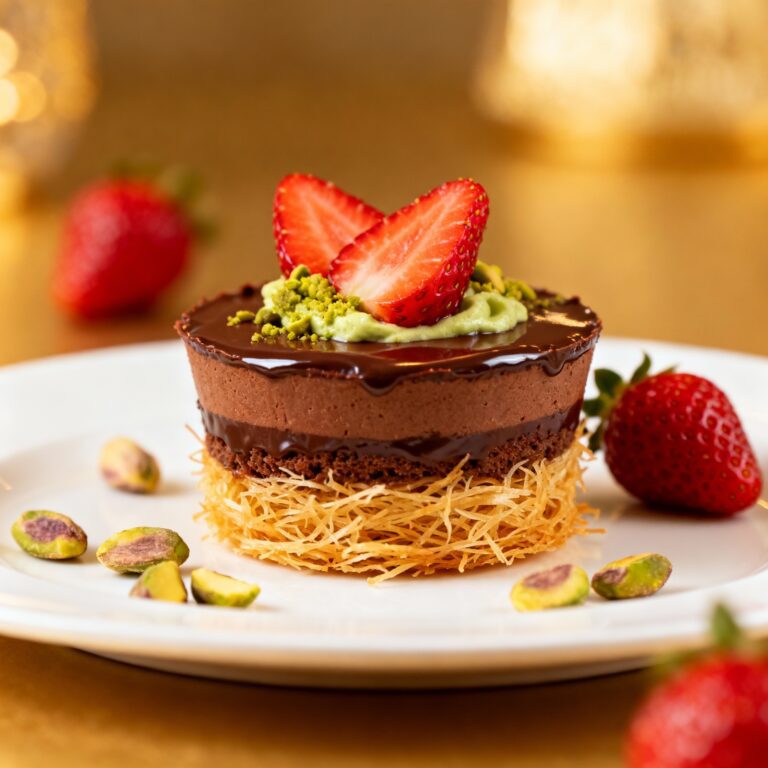Japanese Strawberry Cream Sando : The Sweetest Bite of Simplicity
Strawberry Cream Sando and fluffy whipped cream against soft milk bread.
Discover the art of making Japanese Strawberry Cream Sando a soft, fluffy milk bread sandwich filled with airy whipped cream and juicy strawberries. Perfect for brunch, dessert, or a refreshing summer treat.
For readers who enjoy Japanese desserts, check out our Matcha Cheesecake Tart and Mochi Ice Cream Recipe. These pair beautifully with a warm cup of green tea.
Introduction: A Taste of Japanese Elegance
Imagine soft, cloud-like milk bread, fresh strawberries bursting with sweetness, and a pillow of lightly sweetened whipped cream that melts in your mouth. That’s the Japanese Strawberry Cream Sando a minimalist dessert that captures everything Japan loves about balance, beauty, and flavor.
This isn’t just a snack. It’s an experience. A delicate reminder that sometimes, the simplest things bring the most joy
Why This Recipe Is Trending Now
The Strawberry Cream Sando is enjoying a summer magazine moment. It’s inspired by the Japanese furūtsu sando pillowy white bread, lightly sweet whipped cream, and bright fresh strawberries nesting inside(Bon Appétit).
Moreover, TikTok and Instagram have revived its simple yet elegant charm: side‑by‑side reels of perfect strawberry alignment, fluffy layers, and decadently clean slices are everywhere.
Plus, the recent launches by M\&S and H‑E‑B show huge international buzz fans love the flavor, though some critics debate the bread choice .
How to make strawberry cream sando
Ingredients
The secret to a perfect Strawberry Sando is balance just the right sweetness, just the right creaminess, and bread so soft it feels like air.
- 8 slices Japanese milk bread (shokupan) or soft white bread
- 10–12 ripe strawberries, stems removed
- 1 cup heavy cream
- ¼ cup powdered sugar (sifted)
- 1 tsp vanilla extract
- Optional: mascarpone (for stability, ¼ cup) .
Instructions
- Chill your tools: Pop the mixing bowl and whisk in the fridge for 10 minutes.
- Prepare strawberries: Wash, dry, and slice stems off. Choose uniform fruits for visual impact.
- Whip cream: Beat chilled cream, powdered sugar, and vanilla to medium-stiff peaks (~3–4 min). If using mascarpone, whip it briefly before folding it into the cream.
- Assemble: Place one slice of bread on a clean surface. Spread a thick layer of whipped cream evenly. Arrange strawberries in the center pointy side up for aesthetics. Cover with another thin layer of cream and the second slice of bread.
- Gently press down to seal. Wrap tightly in plastic wrap to help it hold its shape. Chill for at least 30 minutes before slicing.
- Sandwich & press: Gently top with a second bread slice. Wrap tightly in cling film and press slightly to settle. Chill 1 hour.
- Cut: Use a sharp, warm knife. Slice your Strawberry Cream Sando diagonally to reveal the pattern.
For more brunch ideas, explore our Fluffy Japanese Pancakes another crowd-favorite!

Serving Suggestions & Pairings for Strawberry Cream Sando
To turn your Strawberry Cream Sando into a memorable treat, consider these delightful serving ideas that enhance flavor, texture, and presentation:
- Begin with a Matcha Latte or Green Tea
First, serve a gently sweet matcha latte or hot green tea alongside the sando. This pairing creates a lovely balance because the earthy bitterness of tea contrasts nicely with the sweet cream and juicy berries. Moreover, it echoes the sandwich’s Japanese roots, offering an authentic flavor experience . - Also Try a Berry-Infused Sparkling Water
Next, offer sparkling water infused with fresh berries like strawberries or raspberries. As a result, you introduce a refreshing and fizzy element that cleanses the palate between bites and makes the overall experience more elegant. - Serve with a Light Fruit Parfait
Additionally, for a more elaborate dessert spread, pair the sando with a small fruit parfait. Layer yogurt or whipped cream with berries and granola. This side works wonderfully because it echoes the parfait-style presentation popular in Japanese cafés and keeps things visually consistent and classy . - Include Edible Flower Garnishes
Furthermore, add a few edible flowers such as mint blossoms or nasturtiums on the plate. In doing so, you elevate the visual appeal of your Strawberry Cream Sando. This step enhances the “Instagram-ready” feel and makes each slice feel elegant and special. - Offer a Mini Side Salad
Besides sweet touches, consider a small side salad of baby greens lightly tossed with a citrus vinaigrette. Doing so adds a fresh flavor contrast and texture, which can balance the decadent cream and bread with bright, crisp notes . - Finish with a Dusting of Powdered Sugar
Finally, dust the top of each sando with a light sprinkling of powdered sugar just before serving. This adds a delicate sweetness and a graceful finish. Additionally, it keeps everything looking sharp and refined for photos.
Try Also this luxurious Dubai Chocolate Strawberries fusion dessert.
Why These Ideas Work
- They balance sweetness with tea, fruit, and light salad contrasts.
- They add visual flair with color, texture, and elegant plating.
- They reflect cultural context, supporting your recipe narrative.
Quick Plating Tips
- Serve matcha latte in a small ceramic cup beside each sando plate.
- Pour sparkling berry water into a clear glass with fresh fruit.
- Parfait goes in a clear mini glass to show off the layers.
- Place garnish strategically like mint or flowers for color contrast.
- Salad appears on a small side plate to keep it separate.
- Dust powdered sugar right at serving for optimal presentation.
Keep the chill going with this Smores Ice Cream Cake , Or discover the fruity elegance of Blueberry Tiramisu.

Why We Love This Recipe
- Visually stunning: The cross-section of strawberries is a showstopper.
- Quick to make: Takes under 20 minutes.
- Perfect for gatherings: Elegant, refreshing, and easy to prepare ahead of time.
- Low on sugar: Naturally sweetened with fruit.
It’s no wonder foodies across Tokyo adore this dessert it represents the heart of Japanese cooking: minimalism, precision, and joy in simplicity.
The Meaning Behind “Sando”
In Japan, “Sando” is a shortened form of “Sandwich,” reflecting the country’s love of cute abbreviations (known as wasei-eigo). While Western sandwiches are often savory, the Japanese adapted the concept into dessert culture, transforming it into a piece of edible art.
The Fruit Sando emerged in the early 20th century in Tokyo cafés, particularly during the rise of Western-style bakeries. Since then, it has evolved into a beloved comfort food that symbolizes care, simplicity, and joy.
Nutrition & Dietary Notes
This dessert is surprisingly light compared to other pastries. A single sando typically contains:
- Calories: ~220–250 kcal
- Fat: 12–15 g
- Protein: 4 g
- Carbs: 24 g
- Sugar: 12 g
It’s naturally low in refined sugar and relies mostly on fruit sweetness — a hallmark of Japanese desserts.
For a lighter version, try substituting half the cream with Greek yogurt or silken tofu cream for extra protein and less fat.
Food Culture Spotlight: The Japanese Love for Aesthetics
In Japan, presentation is as vital as taste. A Sando isn’t just about flavor it’s about emotion.
According to Serious Eats, convenience stores in Japan sell hundreds of variations daily each one carefully wrapped and perfectly sliced to reveal the fruit’s beauty.
If you love visually pleasing desserts, also check our Sakura Roll Cake and Yuzu Lemon Tart
Pairing Ideas
This dessert pairs wonderfully with:
- A hot cup of matcha latte (see our Homemade Matcha Latte Guide)
- A glass of chilled rosé wine for adults
- Or a Japanese-style fruit tea
Variations You’ll Love
While the strawberry version is the classic, Japan’s fruit sando tradition offers delightful variations:
- Mango & Cream Sando: Use chilled ripe mango for a tropical twist.
- Kiwi & Grape Sando: Perfect for summer picnics — bright, tangy, and colorful.
- Matcha Cream Sando: Add 1 tsp matcha powder to the whipped cream for a subtle earthy flavor.
- Chocolate Hazelnut Sando: Replace part of the cream with Nutella for a richer indulgence.
- Vegan Coconut Sando: Use coconut cream and vegan brioche for a plant-based delight.
Each variation tells a different flavor story from refreshing and fruity to deep and luxurious.
Conclusion
The Japanese Strawberry Cream Sando is more than a dessert it’s a reflection of Japanese culture, where presentation meets precision, and flavor meets balance.
From local convenience stores in Tokyo to high-end cafés in London and New York, this charming creation continues to capture hearts. It reminds us that sometimes, the most memorable dishes come from simplicity just bread, cream, and fruit, arranged with care.
Whether enjoyed with matcha on a quiet afternoon or served as a showpiece for brunch, this Sando will bring a little piece of Japan’s elegance to your table.
So next time you crave something sweet yet refined reach for strawberries, cream, and milk bread. Because beauty, as the Japanese say, often lies in simplicity.
FAQs
Q1. What’s the best bread for a sando?
Stick with Japanese milk bread (shokupan) or a soft crust-less white loaf. Elsewhere, stores may use brioche—both work well. However, avoid thick Texas toast—it’s too heavy and alters the texture .
Q2. Can I prep ahead?
Yes! Wrap and refrigerate for up to 3 hours. Long after that, the bread may absorb too much moisture.
Q3. Any storage tips?
Store in the fridge for up to 24 hours, or freeze wrapped sandwiches for up to a week. Thaw in the refrigerator before serving.
Q4. Can I make it vegan?
Absolutely! Swap cream for coconut cream or vegan whipped alternatives; use vegan bread. See vegan sando tips from Plant Based News .







